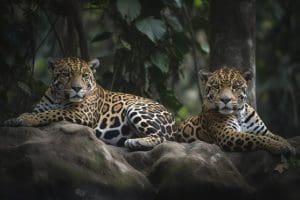Jaguars in Captivity: Preserving the Legacy of these Magnificent Big Cats
Jaguars in Captivity:
Preserving the Legacy of these Magnificent Big Cats
The jaguar, scientifically known as Panthera onca, is a majestic big cat that has captivated humans for centuries. With its powerful build, distinctive coat pattern, and enigmatic behavior, the jaguar holds a special place in our collective imagination. However, due to habitat loss, poaching, and other threats, the population of wild jaguars has been declining rapidly. To ensure the survival of this iconic species, many organizations and zoos around the world have taken up the responsibility of preserving jaguars in captivity. In this article, we will explore the importance of these efforts and the challenges faced in maintaining healthy jaguar populations outside their natural habitat.
The Role of Captive Breeding Programs
 Captive breeding programs play a crucial role in the conservation of endangered species like the jaguar. These programs aim to breed jaguars in captivity to increase their numbers and genetic diversity. By carefully selecting breeding pairs and managing their offspring, zoos and conservation organizations can contribute to the long-term survival of the species.
Captive breeding programs play a crucial role in the conservation of endangered species like the jaguar. These programs aim to breed jaguars in captivity to increase their numbers and genetic diversity. By carefully selecting breeding pairs and managing their offspring, zoos and conservation organizations can contribute to the long-term survival of the species.
One successful example of a captive breeding program is the one implemented by the Wildlife Conservation Society (WCS) in Belize. WCS has been working with local communities and the Belize Zoo to breed jaguars in captivity and release them into the wild. This program has not only helped increase the jaguar population but has also raised awareness about the importance of conserving their natural habitat.
Challenges in Captivity
While captive breeding programs have shown promise, there are several challenges associated with keeping jaguars in captivity. These challenges include:
- Space and Enrichment: Jaguars are large, solitary animals that require ample space to roam and exhibit natural behaviors. Providing suitable enclosures that mimic their natural habitat is essential for their physical and mental well-being.
- Diet and Nutrition: Jaguars have specific dietary requirements that need to be met in captivity. A balanced diet that includes a variety of meats, vitamins, and minerals is crucial for their health and reproduction.
- Genetic Diversity: Maintaining a genetically diverse captive population is essential to prevent inbreeding and the associated health problems. Cooperation between different institutions and careful management of breeding programs can help maintain genetic diversity.
- Reintroduction Challenges: Reintroducing captive-bred jaguars into the wild is a complex process. It requires careful planning, monitoring, and support from local communities to ensure the success of the reintroduction efforts.
Educational and Research Opportunities
Aside from their conservation value, jaguars in captivity also provide unique educational and research opportunities. Zoos and wildlife centers can educate the public about the importance of jaguar conservation and the threats they face in the wild. Through interactive exhibits, educational programs, and research initiatives, visitors can learn about the biology, behavior, and ecological role of jaguars.
Furthermore, studying jaguars in captivity allows researchers to gather valuable data that would be difficult to obtain in the wild. By closely observing their behavior, reproductive patterns, and responses to various stimuli, scientists can gain insights into the species’ biology and contribute to its conservation.
Conclusion
Jaguars are magnificent big cats that are facing numerous threats in the wild. Captive breeding programs and the preservation of jaguars in captivity are essential for their long-term survival. These programs not only help increase the population of jaguars but also provide educational and research opportunities. However, maintaining healthy jaguar populations in captivity comes with its own set of challenges, including space requirements, diet and nutrition, genetic diversity, and successful reintroduction into the wild. By addressing these challenges and continuing to support conservation efforts, we can ensure that the legacy of these magnificent big cats is preserved for future generations.
Read More About Jaguars From Wikipedia



